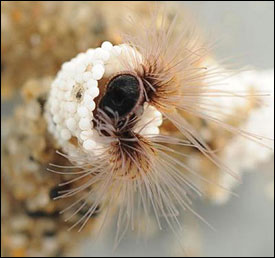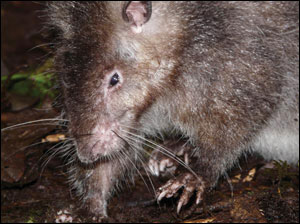|

A special glue
from worms
It may help hold human bones together :
|

The Sandcastle worm in the laboratory has built its shell from
small white beads instead of bits of shell and sand. |
Scientists often look to the natural world for inspiration and ideas.
Now, we may be able to thank an unusual worm for a new kind of
superglue. At the University of Utah in Salt Lake City, scientists have
created a powerful adhesive that works underwater and hardens quickly,
which means it may be useful inside the human body. Most glues don't
work well inside the body, where everything is wet. When surgeons
operate on a person to repair broken bones, for example, they may be
able to use the new glue to hold the bones together.
The Utah scientists were inspired to make the new glue by a little
sea animal called the sandcastle worm. It lives on the coast in an area
between the water levels for high and low tides. During high tide, their
homes are underwater; when the tide goes out, their homes are left high
and dry. This sea creature gets its name from its house. A Sandcastle
worm builds its own house by collecting grains of sand, broken shells
and other debris and stacking these bits all around. The worm also
produces a glue that is used to stick all these pieces together, forming
a solid tube. The worm's glue hardens underwater in less than 30
seconds, and within a few hours the glue gets tough like leather.
Russell Stewart, one of the scientists who worked on the new glue,
says that in the same way the sandcastle worm glues together grains of
sand, surgeons may be able to glue together broken bones. The worm
"literally glues skeletons together underwater, so we thought it would
be a good model for wet surgery," he says.
Stewart, who is a bioengineer at the University of Utah in Salt Lake
City, and his colleagues set out to understand the worm's adhesive, so
they could then make their own. First, they studied the Sandcastle
worm's glue in the laboratory. They found many proteins, which are tiny
molecules that are the construction material of most living things. The
researchers learned which proteins give the glue its super-sticking
power by studying the proteins structures. Half the proteins had strong
positive or negative electric charges. Positive and negative charges are
attracted to each other and stick together, and this helped make the
glue extra sticky. Once they identified and understood the proteins, the
scientists made their own version of the glue in the laboratory. They
tested their creation and found that it worked underwater "and was about
twice as strong as the worm glue. Further tests showed that the glue
isn't poisonous to human cells. At the end of the experiment, the
scientists had invented a new superstrong glue that worked underwater
and was not toxic, which means it didn't cause harm. These three
qualities"strong, working underwater, nontoxic" could make the glue an
important part of surgeries in the future. Plus, researchers are now
looking at ways to make the glue able to dissolve, which means that over
time, as the bones healed, the glue would disappear. Stewart and his
team may have found a new way to help bones heal"all because of a funny
little worm on the beach. Courtesy: Science News
New species of
giant rat discovered
"A Smithsonian Institution biologist, working with the Natural
History Unit of the BBC, has discovered a new species of giant rat on a
filmmaking expedition to a remote rainforest in New Guinea.The discovery
was made in the crater of an extinct volcano named Mount Bosavi in Papua
New Guinea's Southern Highlands province. This gigantic volcano's crater
is two and half miles wide and rimmed with walls nearly half a mile
high, trapping the creatures inside a "lost world" of mountain
rainforests
|

Bosavi wooly rat is one of the biggest rats in the world. |
probably rarely visited by humans.Kristofer Helgen, curator of
mammals at the Smithsonian's National Museum of Natural History in
Washington, D.C., and Muse Opiang, a biologist with the Papua New Guinea
Institute of Biological Research, were first on the scene when the rat
was found by a tracker from the Kasua tribe that lives outside the
crater.Weighing nearly 3.5 pounds, and measuring 32 inches from nose to
tail, the Bosavi woolly rat is one of the biggest rats in the world.
Most surprising was that the rat was completely tame, a sign that
animals in the isolated crater were unfamiliar with humans. "It is a
true rat, closely related to the rats and mice most of us are familiar
with, but so much bigger," said Helgen.
The gigantic rat is silvery grey, with thick woolly fur. It has a
vegetarian diet of leaves and roots, and probably builds underground
nests beneath rocks and tree roots. A member of the genus Mallomys, it
has yet to receive its formal scientific name.
The discovery came in the middle of the night after days of searching
in the crater's chilly mountain rainforests, often in the pouring rain.
"Our hearts were in our throats," said Helgen. "It was an unbelievably
exciting moment. It was all the more incredible that the BBC was there
to film it." "As biologists, we spend plenty of cold, muddy nights in
the rain, but rarely can we expect to be rewarded like this," said
Opiang.New Guinea is famous for its diversity of rodents. More than 70
species of rats and mice (the rodent family Muridae) can be found on the
tropical island, several of which have been named as new species in the
past by Helgen.
It is currently estimated that along with the new species of giant
rat, the expedition found approximately 16 species of frogs, one species
of gecko, three species of fish, and at least 20 species of insects and
spiders. Also on the list is an animal Helgen calls the Bosavi Silky
Cuscus, which may be a new subspecies of tree-living marsupial.
The animal "which looks like a small bear" is a marsupial that feeds
on fruits and leaves. Weighing 5 pounds, it has dense silky fur adapted
for a mountain environment. "Finding an animal like this for the first
time in the 21st century is certainly cause for celebration", said
Opiang.
Rainforest habitats in Mount Bosavi's crater are currently pristine,
but extensive logging operations can be found just a few miles to the
south. "Discoveries like this should remind us how much of the world is
still left to explore," said Helgen, and also how much stands to be lost
when any rainforest is threatened.
-Science Daily
Name: Nuwanga Shanuka
Amarasekara
Gender: Male
Age: 14
Hobbies: Collecting
stamps, playing computer games, chess, reading books
Pen-pals preferred from:
India, Finland, New Zealand, USA, UK, Australia, Sri Lanka
Age group: 12-14
Address: No. 118, 4th
Lane, Dikhenapura, Horana, Sri Lanka.
Name: Kavinda Fernando
Gender: Male
Age: 12
Hobbies: Collecting
stamps, reading books, karate, swimming, watching TV, playing chess
Pen-pals preferred from:
Any country
Address: No. 18,
Mahahunupitiya, Negombo, Sri Lanka.
Name: Sithara Rajapaksha
Gender: Female
Age: 17
Hobbies: Climbing
mountains, swimming, dancing, reading books
Pen-pals preferred from:
England, Australia, Canada, New Zealand, Sri Lanka
Address: 3/15, Baduwatta,
Madelgamuwa, Gampaha, Sri Lanka. |

